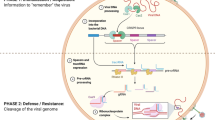Abstract
Purpose
Silencing of HPV oncogenes or their human host client proteins using topically applied small interfering RNA (siRNA) may be an attractive nonsurgical strategy for CIN treatment. An exploratory clinical investigation was designed to evaluate E6-AP mRNA expression levels in different stages of cervical intraepithelial neoplasia and during the menstrual cycle.
Methods
In 38 premenopausal women aged 18–45 years referred to colposcopy clinic, analysis of serum hormones, cervical smears for cytology and HPV DNA, cervical biopsy, p16 immunohistochemistry and E6-AP mRNA expression levels in cervical smears and biopsies were performed. The intra-subject variability in E6-AP mRNA expression of vaginal smears was assessed and compared to cervical biopsy specimens.
Results
RNA of sufficient quantity and quality was available for E6-AP expression analysis from 97 % of the collected cervical smears and from 56 % of the collected biopsy samples. The normalized RNA levels from cervical smears were approximately tenfold higher compared to biopsies. There was little influence by the phase of the menstrual cycle or by CIN stage. Real-time PCR showed that the expression level of E6-AP is in a range (<28 C t) that would allow for detection of at least 100-fold modulation by a therapeutic agent (based on an assay LOD of C t = 36).
Conclusions
Our findings suggest a potential therapeutic approach using E6-AP siRNA as a specific molecular target in cervical intraepithelial neoplasia.



Similar content being viewed by others
References
Arbyn M, Kyrgiou M, Simoens C, Raifu AO, Koliopoulos G, Martin-Hirsch P et al (2008) Perinatal mortality and other severe adverse pregnancy outcomes associated with treatment of cervical intraepithelial neoplasia: meta-analysis. BMJ(Clinical research ed) 337:a1284
Brun JL, Dalstein V, Leveque J, Mathevet P, Raulic P, Baldauf JJ et al (2011) Regression of high-grade cervical intraepithelial neoplasia with TG4001 targeted immunotherapy. Am J Obstet Gynecol 204(2):169e1–169e8
Einstein MH, Kadish AS, Burk RD, Kim MY, Wadler S, Streicher H et al (2007) Heat shock fusion protein-based immunotherapy for treatment of cervical intraepithelial neoplasia III. Gynecol Oncol 106(3):453–460
Young JL, Jazaeri AA, Darus CJ, Modesitt SC (2008) Cyclooxygenase-2 in cervical neoplasia: a review. Gynecol Oncol 109(1):140–145
Hillemanns P, Wang X, Hertel H, Andikyan V, Hillemanns M, Stepp H et al (2008) Pharmacokinetics and selectivity of porphyrin synthesis after topical application of hexaminolevulinate in patients with cervical intraepithelial neoplasia. Am J Obstet Gynecol 198(3):300e1–300e7
Hausen H (2002) Papillomaviruses and cancer: from basic studies to clinical application. Nat Rev Cancer 2(5):342–350
Schiffman M, Wentzensen N, Wacholder S, Kinney W, Gage JC, Castle PE (2011) Human papillomavirus testing in the prevention of cervical cancer. J Natl Cancer Inst 103(5):368–383
Hawley-Nelson P, Vousden KH, Hubbert NL, Lowy DR, Schiller JT (1989) HPV16 E6 and E7 proteins cooperate to immortalize human foreskin keratinocytes. EMBO J 8:3905–3910
Munger K, Phelps WC, Bubb V, Howley PH, Schlegel R (1989) The E6 and E7 genes of the human papillomavirus type 16 together are necessary and sufficient for transformation of primary human keratinocytes. J Virol 63:4417–4421
Peralta-Zaragoza O, Bermudez-Morales VH, Madrid-Marina V (2010) RNA interference: biogenesis molecular mechanisms and its applications in cervical cancer. Rev Invest Clin 62(1):63–80
Chen XZ, Zhu KJ, Xu Y, Tang XY, Cai XZ, Zhang X et al (2010) RNA interference silences the human papillomavirus 6b/11 early gene E7 in vitro and in vivo. Clin Exp Dermatol 35(5):509–515
Hengstermann A, D’Silva MA, Kuballa P, Butz K, Hoppe-Seyler F, Scheffner M (2005) Growth suppression induced by downregulation of E6-AP expression in human papillomavirus-positive cancer cell lines depends on p53. J Virol 79(14):9296–9300
Tomaic V, Pim D, Banks L (2009) The stability of the human papillomavirus E6 oncoprotein is E6AP dependent. Virology 393(1):7–10
Shai A, Pitot HC, Lambert PF (2010) E6-associated protein is required for human papillomavirus type 16 E6 to cause cervical cancer in mice. Cancer Res 70(12):5064–5073
Opalinska JB, Gewirtz AM (2002) Nucleic-acid therapeutics: basic principles and recent applications. Nat Rev Drug Discov 1(7):503–514
Kim B, Tang Q, Biswas PS, Xu J, Schiffelers RM, Xie FY et al (2004) Inhibition of ocular angiogenesis by siRNA targeting vascular endothelial growth factor pathway genes: therapeutic strategy for herpetic stromal keratitis. Am J Pathol 165(6):2177–2185
Mizui T, Yamashina S, Tanida I, Takei Y, Ueno T, Sakamoto N et al (2010) Inhibition of hepatitis C virus replication by chloroquine targeting virus-associated autophagy. J Gastroenterol 45(2):195–203
Jonson AL, Rogers LM, Ramakrishnan S, Downs LS Jr (2008) Gene silencing with siRNA targeting E6/E7 as a therapeutic intervention in a mouse model of cervical cancer. Gynecol Oncol 111(2):356–364
Jung HS, Erkin OC, Kwon MJ, Kim SH, Jung JI, Oh YK et al (2011) The synergistic therapeutic effect of cisplatin with Human papillomavirus E6/E7 short interfering RNA on cervical cancer cell lines in vitro and in vivo. Int J Cancer 130(8):1925–1936
Yamato K, Egawa N, Endo S, Ui-Tei K, Yamada T, Saigo K et al (2011) Enhanced specificity of HPV16 E6E7 siRNA by RNA-DNA chimera modification. Cancer Gene Ther 18(8):587–597
Acknowledgments
This study was supported in part by a grant from the Novartis Institute of BioMedical Research.
Conflict of interest
The authors declare no financial, personal, or professional conflicts of interest.
Author information
Authors and Affiliations
Corresponding author
Rights and permissions
About this article
Cite this article
Hillemanns, P., Jentschke, M., Evans, T.G. et al. Detection of E6-AP as a potential therapeutic target in cervical specimen of HPV-infected women. Arch Gynecol Obstet 289, 1281–1286 (2014). https://doi.org/10.1007/s00404-013-3120-5
Received:
Accepted:
Published:
Issue Date:
DOI: https://doi.org/10.1007/s00404-013-3120-5




